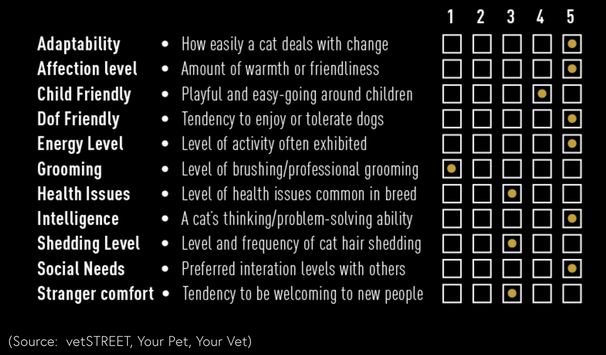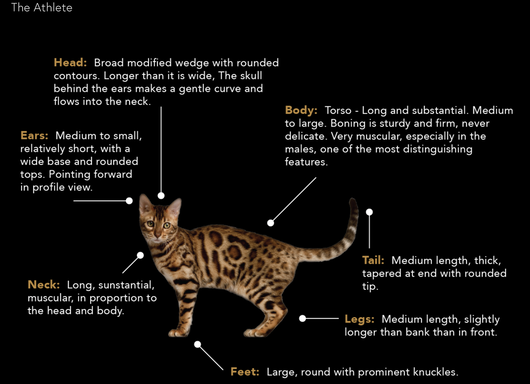Bengal Characteristics |
Bengals are very intelligent and will often try talking to you or letting their feeling be known.
If your looking for a quiet companion, A Bengal may not be for you. Most Bengal owners love chatting with them. |
Why does the Bengal cat have a different personality?
Is Bengal right for you? See also - Is a Bengal kitten right for you
Almost everyone agrees that a Bengal kitten is really cute! But is the Bengal cat’s personality right for you?
Before adopting a Bengal cat, it is better to know more about the temperament and personality of this beautiful breed.
Why does the Bengal cat have a different personality?
The Bengal cat was created by a crossbreeding of the domestic cat and the small Asian leopard. This little leopard from the jungle has left several personality traits to the Bengal cat. But do not be afraid, the Bengal cat has a really affectionate temperament!
What is the Bengal cat’s personality like?
The Bengal cat has an extremely intelligent and active personality. By nature, he is a hunter who loves to play, climb and perch high. You will make him very happy by providing a cat tree and a cat wheel. You can easily teach him a lot of things, such as fetching the ball, and he will rush to you as soon as you call him.
It’s great living with a Bengal cat, but expect to spend time with them. The Bengal cat requires attention. They love you and wants to spend time with you. And of course, they can be mischievous! But these little creatures are so beautiful and have an adorable personality which helps to forgive them very quickly.
Very affectionate, he will lie on your legs or follow you everywhere in the house. You will fall for the personality
of your Bengal cat much more than you would ever think!
How is the Bengal cat with children and other animals?
Bengal cats enjoys the company of children and other animals, even dogs, because their presence puts action in their life. People who do not have children or other animals will decide on having a 2nd Bengal so they can have fun and play together. As the Bengal cat has a hunting instinct, he should not be left alone with small animals like birds, guinea pigs, hamsters or small rabbits. See Also why two Bengals are better than One
Do all Bengal cats have a good character?
Their characters and personality traits will vary from one cat to another. The choice of the Breeder is of the utmost importance, since the kitten’s socialization made by the breeder during the first weeks of life will have a direct impact on the future temperament. For a Bengal cat to be kind and affectionate, he must be socialized and be cared for from an early age. Also, kittens often have the temperament of their parents, so it is important to carefully select breeding Bengal cats that have nice personalities.
At Registered Bengals, temperament is a priority. Our Bengal kittens are born and grow in the heart of our living room. They are filled with love and attention all day long! They are simply adorable.
Do Bengals like to go outside?
In fact, they love the outdoors! The Bengal cat’s favorite activity is watching and listening to birds, so much so that you will need to keep a close eye on the doors and windows of your house. The Bengal cats would love an outdoor enclosure or walk on a leash with a harness.
NEVER let your Bengal cat outside unsupervised.
WHAT A BENGAL THINKS:
Almost everyone agrees that a Bengal kitten is really cute! But is the Bengal cat’s personality right for you?
Before adopting a Bengal cat, it is better to know more about the temperament and personality of this beautiful breed.
Why does the Bengal cat have a different personality?
The Bengal cat was created by a crossbreeding of the domestic cat and the small Asian leopard. This little leopard from the jungle has left several personality traits to the Bengal cat. But do not be afraid, the Bengal cat has a really affectionate temperament!
What is the Bengal cat’s personality like?
The Bengal cat has an extremely intelligent and active personality. By nature, he is a hunter who loves to play, climb and perch high. You will make him very happy by providing a cat tree and a cat wheel. You can easily teach him a lot of things, such as fetching the ball, and he will rush to you as soon as you call him.
It’s great living with a Bengal cat, but expect to spend time with them. The Bengal cat requires attention. They love you and wants to spend time with you. And of course, they can be mischievous! But these little creatures are so beautiful and have an adorable personality which helps to forgive them very quickly.
Very affectionate, he will lie on your legs or follow you everywhere in the house. You will fall for the personality
of your Bengal cat much more than you would ever think!
How is the Bengal cat with children and other animals?
Bengal cats enjoys the company of children and other animals, even dogs, because their presence puts action in their life. People who do not have children or other animals will decide on having a 2nd Bengal so they can have fun and play together. As the Bengal cat has a hunting instinct, he should not be left alone with small animals like birds, guinea pigs, hamsters or small rabbits. See Also why two Bengals are better than One
Do all Bengal cats have a good character?
Their characters and personality traits will vary from one cat to another. The choice of the Breeder is of the utmost importance, since the kitten’s socialization made by the breeder during the first weeks of life will have a direct impact on the future temperament. For a Bengal cat to be kind and affectionate, he must be socialized and be cared for from an early age. Also, kittens often have the temperament of their parents, so it is important to carefully select breeding Bengal cats that have nice personalities.
At Registered Bengals, temperament is a priority. Our Bengal kittens are born and grow in the heart of our living room. They are filled with love and attention all day long! They are simply adorable.
Do Bengals like to go outside?
In fact, they love the outdoors! The Bengal cat’s favorite activity is watching and listening to birds, so much so that you will need to keep a close eye on the doors and windows of your house. The Bengal cats would love an outdoor enclosure or walk on a leash with a harness.
NEVER let your Bengal cat outside unsupervised.
WHAT A BENGAL THINKS:
- Where are my servants? I like being entertained
- Action, bring it on! You will not be bored with me
- I love children and all other animals because they bring action into my life!
- Protect the fishes, I love to play with them
- I like comfort; I wonder where I could take my nap
- What kind of mischief can I get into today
- I feel like chatting with my master, Bengals are Vocal
- I need some love, who should I cuddle with
- It’s forbidden to go there … I wonder why
- I love to play in the water
- I will quickly find the highest point in the house so I can perch there
- I am very active and sometimes even at night
- What could I do to make my master laugh?
Bengal Cat Body Language
Basic Cat Behavior
It is certain that the cat thinks of a human differently than it does other cats (i.e., it does not think of itself as human, nor that the human is a cat). This can be seen in the difference in body and vocal language it uses with the human, when compared to how it communicates with other cats in the household.
Some have suggested that, psychologically, the human keeper of a cat is a sort of surrogate for the cats mother and those adult domestic cats live forever in a kind of suspended kitten hood. With proper training and reinforcement of social behaviour, poorly socialized cats can become more social over time. A cat that has been made a 'stray' or has been mistreated, can in time, with patience and understanding, become a social, family cat.
Understanding your cat is an important part of your relationship with your pet. A cats body language can tell you a lot about its mood. Cats communicate a variety of messages using cat body language. Examples include arching their backs as a signal of fear or aggression, and slowly blinking to signal relaxation.
Tail
As is the case with dogs, the tail is often used as a signalling mechanism. A flick or twitch can indicate minor irritation and a tail held high suggests confidence. In addition, a cats tail may 'wag' or move rapidly to express a state of conflict. A cat who chooses to lie with its stomach and chest exposed conveys happiness, trust and comfort (this is also typical of overweight cats, as it is more comfortable for them), however, a cat may also roll on its side/back to be able to defend itself with all four sets of claws.
When the tail is erect for its full length, it is used as a greeting to another cat or to a friendly human and is an invitation for contact rubbing. The tail that is wrapped against the cats body may mean that the cat is contented or for a nervous cat, it is a defensive posture.
Ears
If the tail alone does not give you enough information about what the cat is thinking, take a look at their ears. Cats involved in a standoff will make threatening sounds, however, to really understand what is happening, check the ear position. The defenders ears will lie down flat against the head for protection.
The cat whose ears are lying flat, but with a twist, so that the tips of the back of the ear can be seen from the front, is the aggressor. Forward-pointing ears are used by confident, curious, cats to listen for sounds in front of them. A cat that is hunting prey (or playing) will also keep its ears forward to collect as much auditory information as possible in order to execute a successful pounce.
Eyes
In a standoff situation, the defending cats pupils will be dilated to provide the cat with wider peripheral vision, an advantage in anticipating an attack. The aggressors pupils narrow to give him better depth perception, an advantage in judging where to attack. While dilated pupils can indicate fear, they are also indicative of the light conditions. In dim light the pupils expand to allow as much light to enter the eye as possible.
Perhaps one of the most wonderful of feline body signals, but one that is most often missed, is the slow eye blink. Blinking is a very powerful communication used between cats when they are sitting or lying down. Slow blinking towards a cat shows that you are not a threat and they will most likely return the slow blink telling you that they feel comfortable with you and they like you. It is also a great way to say 'I love you' to your favourite feline companion.
Greeting
Cats normally greet each other by rubbing faces. When a cat greets you by standing on its hind legs, it is simply trying to reach your face. If you were to lower yourself so your face is within reach, your cat will rub their face with yours. This is only done to humans that the cat trusts.
Another friendly way for a cat to greet its owner is to roll on its back, stretching its legs as far as possible, yawning and exercising its claws. The "belly-up" position is a very vulnerable position, it indicates total trust of the person involved. It is a lazy way for the cat to greet its owner, a more active cat would probably rub itself against your legs. Cats have scent glands on the temples, around the mouth and at the base of the tail. When a cat rubs itself against you, it is rubbing off some of its scent to say "this is mine". Only other cats can smell this scent.
Kneading
Kneading is when a cat extends and retracts its claws, usually when it is resting on its owner's lap. This behaviour comes from kitten hood, kittens knead their mother while suckling to make the milk flow more freely. Adult cats will do this when they feel safe and contented. They see their owners as surrogate mothers and, as pampered pets, will retain some kitten characteristics through their adult life. If the cat dribbles or sucking of the owners clothes happens whilst kneading, the cat in question will probably have been taken from its mother too early and never had a chance to grow out of the behaviour naturally. These behaviours are usually for life.
Flehmening
Flehmening is when a cat screws up its face, the lips curl back baring its upper and lower teeth allowing more chemical aromas to register in the Jackobsen's Organ. The Jackobsen's Organ is situated in the roof of the mouth in two sacks. In wild cats this aids in knowing the "lie of the land", and aids in knowing what other animals may be in close proximity. In the domestic cat this is not so important as with the wild cat and the flehmening reaction is not so obvious. The Jackobsen's Organ is also connected to the part of the cats brain concerned with sexual behaviour and appetite.
Gifts
Owners of outdoor cats will eventually be presented with gifts of dead creatures, such as mice and birds. For the cat, this is perfectly natural this behaviour should never be punished in any way. A Queen will bring prey home to her kittens to introduce them to hunting. For this reason, the behaviour is most often seen in female cats. Neutered cats that have no kittens of their own and male cats will also bring gifts home.
Burying Faeces
A subordinate cat will bury its faeces so as not to demonstrate its presence to more dominant cats. A dominant cat will leave its faeces uncovered. A cat kept on their own will bury its Faeces by scratching on the litter tray, this has nothing to do with cleanliness - it is a sign that the cat feels that its owner is dominant. In households with more than one cat, you will often find that one or two cats leave their faeces uncovered, whereas the rest will cover it up.
Wagging Tail
A wagging tail could mean the cat is angry or can mean that the cat is feeling indecisive - it wants to do two things at once and cannot make up its mind which action to take.
Eating Grass
Eating grass often occurs when the cat needs to clean out its stomach by vomiting (maybe to get rid of furballs). If your cat does not have access to grass, house plants or anything similar will be used by your cat. Vomiting will occur soon after the cat has eaten grass. It has been said that cats eat grass to obtain "Folic Acid", something that cats need in minute quantities for its well-being. "Folic Acid" cannot be obtained from meat.
Basic Cat Behavior
It is certain that the cat thinks of a human differently than it does other cats (i.e., it does not think of itself as human, nor that the human is a cat). This can be seen in the difference in body and vocal language it uses with the human, when compared to how it communicates with other cats in the household.
Some have suggested that, psychologically, the human keeper of a cat is a sort of surrogate for the cats mother and those adult domestic cats live forever in a kind of suspended kitten hood. With proper training and reinforcement of social behaviour, poorly socialized cats can become more social over time. A cat that has been made a 'stray' or has been mistreated, can in time, with patience and understanding, become a social, family cat.
Understanding your cat is an important part of your relationship with your pet. A cats body language can tell you a lot about its mood. Cats communicate a variety of messages using cat body language. Examples include arching their backs as a signal of fear or aggression, and slowly blinking to signal relaxation.
Tail
As is the case with dogs, the tail is often used as a signalling mechanism. A flick or twitch can indicate minor irritation and a tail held high suggests confidence. In addition, a cats tail may 'wag' or move rapidly to express a state of conflict. A cat who chooses to lie with its stomach and chest exposed conveys happiness, trust and comfort (this is also typical of overweight cats, as it is more comfortable for them), however, a cat may also roll on its side/back to be able to defend itself with all four sets of claws.
When the tail is erect for its full length, it is used as a greeting to another cat or to a friendly human and is an invitation for contact rubbing. The tail that is wrapped against the cats body may mean that the cat is contented or for a nervous cat, it is a defensive posture.
Ears
If the tail alone does not give you enough information about what the cat is thinking, take a look at their ears. Cats involved in a standoff will make threatening sounds, however, to really understand what is happening, check the ear position. The defenders ears will lie down flat against the head for protection.
The cat whose ears are lying flat, but with a twist, so that the tips of the back of the ear can be seen from the front, is the aggressor. Forward-pointing ears are used by confident, curious, cats to listen for sounds in front of them. A cat that is hunting prey (or playing) will also keep its ears forward to collect as much auditory information as possible in order to execute a successful pounce.
Eyes
In a standoff situation, the defending cats pupils will be dilated to provide the cat with wider peripheral vision, an advantage in anticipating an attack. The aggressors pupils narrow to give him better depth perception, an advantage in judging where to attack. While dilated pupils can indicate fear, they are also indicative of the light conditions. In dim light the pupils expand to allow as much light to enter the eye as possible.
Perhaps one of the most wonderful of feline body signals, but one that is most often missed, is the slow eye blink. Blinking is a very powerful communication used between cats when they are sitting or lying down. Slow blinking towards a cat shows that you are not a threat and they will most likely return the slow blink telling you that they feel comfortable with you and they like you. It is also a great way to say 'I love you' to your favourite feline companion.
Greeting
Cats normally greet each other by rubbing faces. When a cat greets you by standing on its hind legs, it is simply trying to reach your face. If you were to lower yourself so your face is within reach, your cat will rub their face with yours. This is only done to humans that the cat trusts.
Another friendly way for a cat to greet its owner is to roll on its back, stretching its legs as far as possible, yawning and exercising its claws. The "belly-up" position is a very vulnerable position, it indicates total trust of the person involved. It is a lazy way for the cat to greet its owner, a more active cat would probably rub itself against your legs. Cats have scent glands on the temples, around the mouth and at the base of the tail. When a cat rubs itself against you, it is rubbing off some of its scent to say "this is mine". Only other cats can smell this scent.
Kneading
Kneading is when a cat extends and retracts its claws, usually when it is resting on its owner's lap. This behaviour comes from kitten hood, kittens knead their mother while suckling to make the milk flow more freely. Adult cats will do this when they feel safe and contented. They see their owners as surrogate mothers and, as pampered pets, will retain some kitten characteristics through their adult life. If the cat dribbles or sucking of the owners clothes happens whilst kneading, the cat in question will probably have been taken from its mother too early and never had a chance to grow out of the behaviour naturally. These behaviours are usually for life.
Flehmening
Flehmening is when a cat screws up its face, the lips curl back baring its upper and lower teeth allowing more chemical aromas to register in the Jackobsen's Organ. The Jackobsen's Organ is situated in the roof of the mouth in two sacks. In wild cats this aids in knowing the "lie of the land", and aids in knowing what other animals may be in close proximity. In the domestic cat this is not so important as with the wild cat and the flehmening reaction is not so obvious. The Jackobsen's Organ is also connected to the part of the cats brain concerned with sexual behaviour and appetite.
Gifts
Owners of outdoor cats will eventually be presented with gifts of dead creatures, such as mice and birds. For the cat, this is perfectly natural this behaviour should never be punished in any way. A Queen will bring prey home to her kittens to introduce them to hunting. For this reason, the behaviour is most often seen in female cats. Neutered cats that have no kittens of their own and male cats will also bring gifts home.
Burying Faeces
A subordinate cat will bury its faeces so as not to demonstrate its presence to more dominant cats. A dominant cat will leave its faeces uncovered. A cat kept on their own will bury its Faeces by scratching on the litter tray, this has nothing to do with cleanliness - it is a sign that the cat feels that its owner is dominant. In households with more than one cat, you will often find that one or two cats leave their faeces uncovered, whereas the rest will cover it up.
Wagging Tail
A wagging tail could mean the cat is angry or can mean that the cat is feeling indecisive - it wants to do two things at once and cannot make up its mind which action to take.
Eating Grass
Eating grass often occurs when the cat needs to clean out its stomach by vomiting (maybe to get rid of furballs). If your cat does not have access to grass, house plants or anything similar will be used by your cat. Vomiting will occur soon after the cat has eaten grass. It has been said that cats eat grass to obtain "Folic Acid", something that cats need in minute quantities for its well-being. "Folic Acid" cannot be obtained from meat.


























